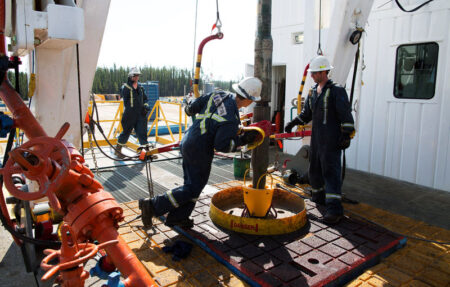Investing.com – The Saudi braggadocio that they can keep surprising the oil market with higher and higher production cuts may have actually done them in.
Crude prices fell another 2% on Thursday, adding to the previous session’s 6% plunge — which was already the most in a year — as the market continued to reel from disappointment over the absence of a new announcement on production cuts at the just-concluded OPEC+ meeting chaired by the Saudis.
Short-covering by some oil bears closing out their positions for profit and bargain hunting by new buyers for crude at below $90 a barrel helped prop the market up earlier.
At the close though, New York-traded West Texas Intermediate, or , crude for delivery in November settled down $1.91, or 2.3%, at $82.31 per barrel. WTI traded as high as $84.30 earlier in the session before hitting an intraday bottom of $82.28, its lowest in five weeks.
“With WTI failing to find buyers at $84, the decline can extend to $81,” said Sunil Kumar Dixit, a technical chartist for oil at SKCharting.com.
London-traded for the most-active December contract settled down $1.74, or 2%, at $84.07. From an intraday high of $86.50, the global crude benchmark went to a five-week low of $83.84.
Part of the selloff in crude was due to the broad run-up since July in the and US which had weighed on the international demand for oil denominated in the US currency.
“This oil market reversal must be frustrating the Saudis,” said Ed Moya, analyst at online trading platform OANDA. “Brent crude has fallen over $10 since the end of last month as surging global bond yields have crippled the global growth outlook.”
“Energy stocks have gone from Wall Street’s best trade to it is time to abandon ship. US gasoline demand destruction is intensifying and given how overbought the energy market was in September, momentum oil selling has been fierce.”
Huge US gasoline stockpiles defy oil demand narrative
jumped by 6.481 million barrels last week, adding to the prior week’s growth of 1.027M. It was the single largest weekly build in gasoline since January 2022. Analysts tracked by Investing.com had anticipated a drop of 0.3M barrels instead last week for gasoline, America’s foremost fuel product..
Also weighing on crude prices was talk that global oil production could grow in coming months despite OPEC’s best efforts to fence in output, said Stephen Innes of SPI Asset Management.
“Demand destruction always plays a crucial role in eventually easing price pressures,” Innes said. “Increasing chatter about more non-OPEC supply coming to market is not working in the bull market’s favor this week,”
OPEC+ is made up of the 13-member Saudi-led Organization of the Petroleum Exporting Countries and the 10 independent oil producers, including Russia. At Wednesday’s meeting, the alliance reaffirmed the joint Saudi-Russian pledge to continue removing at least 1.3 million barrels a day from the combined daily production of the two countries until the end of the year.
But OPEC+ did not talk about extending those cuts into 2024, something the oil trade had come to expect after Saudi Arabia had created the impression in recent months that it can continue surprising the world with one production squeeze after another.
“Oil markets didn’t like that,” Innes said, referring to the absence of a new announcement on cuts.
Back in August, the Saudi Press Agency first communicated to the market that production cuts could be prolonged and deepened, keeping up with the aspirations of the nation’s energy minister Abdul Aziz bin Salman, who has branded himself as the oil market’s “Dirty Harry” — the Hollywood maverick cop known for playing by his own rules with both criminals and his superiors.
While crude prices had gained almost 30% in the third quarter, some of the minister’s handiwork was being undone now. This week alone, WTI was down 9% and Brent almost 12%, with many analysts admitting they had no idea how long the selloff could last.
“When oil prices tank, it is hard to estimate where prices could find support,” Moya said.
He didn’t rule out the possibility of the Saudis, who practically control every aspect of OPEC, in trying to return to their game of one-upmanship.
“Further bearishness could also trigger further output cuts by OPEC+,” said Moya. “OPEC+ worked hard to get oil back to $90 a barrel and they will likely continue to do whatever it takes to make sure we don’t see prices return to the lows of the year, which is around the $70 level.”
(Peter Nurse contributed to this item)
Read the full article here












